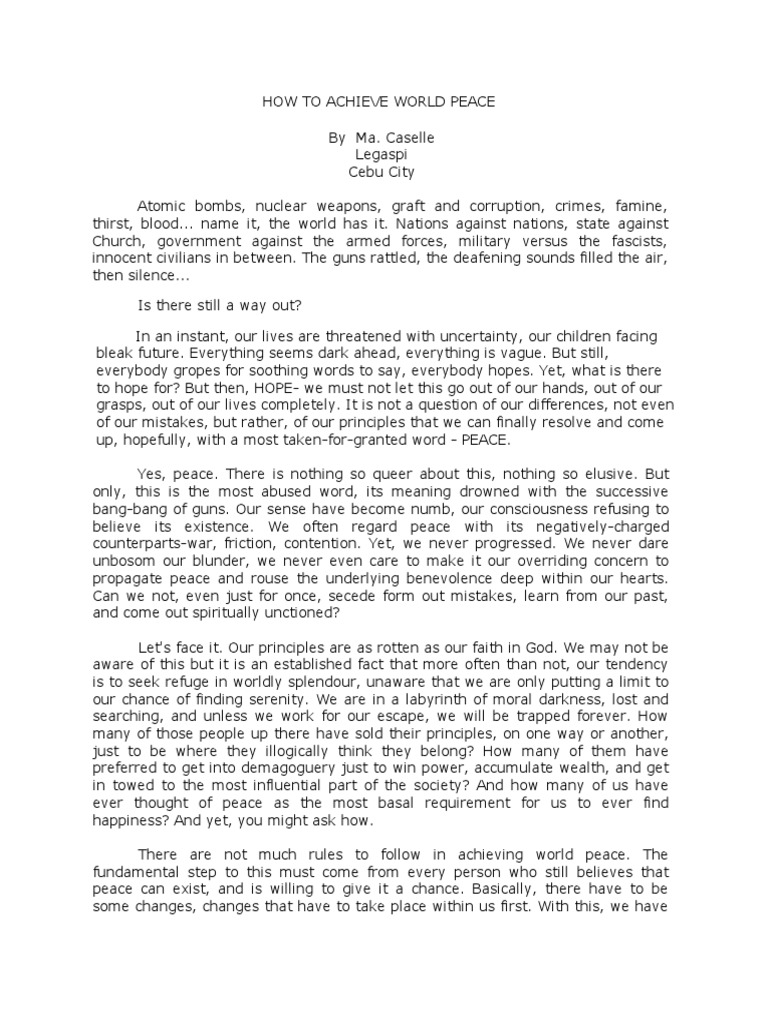World peace is as elusive as a mirage—captivating yet distant, a promise on the horizon that beckons humanity forward. Achieving such an ideal demands more than good intentions; it requires a profound transformation in individual and collective consciousness. The teachings of the Bahá’í Faith offer a comprehensive framework for humanity’s journey towards a harmonious world. Below is a step-by-step exploration of these principles, presenting them in a manner that highlights their unique appeal and metaphorical depth.
1. The Foundation of Oneness
At the core of Bahá’í teachings lies the principle of the oneness of humanity. This concept serves as the bedrock upon which the edifice of world peace must be built. Imagine a vast mosaic, where each tile represents a different culture, race, and belief system. When viewed as separate entities, the individual tiles are mere fragments. However, when unified, they form a breathtaking piece of art that reflects the diversity and richness of humanity. Emphasizing interconnectedness fosters empathy and understanding, bridging the chasms created by prejudice and discrimination.
2. The Power of Education
Education serves as the catalyst for transformation; it ignites the spark of potential within individuals, illuminating the path toward enlightenment. In Bahá’í thought, education transcends mere literacy. It is a holistic development of the human spirit, encompassing moral, ethical, and practical dimensions. Consider the image of a garden, where knowledge is the sunlight nurturing seedlings. Without it, the plants cannot flourish. By advocating for universal access to education, Bahá’í teachings dismantle the barriers that perpetuate inequality and discord.
3. The Role of Justice
Justice is often likened to a scale, balancing the needs and rights of individuals against the demands of societal welfare. In pursuit of world peace, justice takes on the role of a compass guiding humanity through turbulent waters. Bahá’í teachings emphasize the necessity of fairness in all aspects, whether addressing disputes or rectifying historical wrongs. Picture a river that flows smoothly when it is unobstructed by debris. Similarly, justice paves the way for societal harmony, enabling individuals and communities to thrive in an environment free from oppression and inequity.
4. The Art of Consultation
Consultation emerges as a distinctive Bahá’í practice, fostering deliberation and collective decision-making. It is not a mere exchange of opinions but a collaborative journey toward understanding and truth. Visualize a symphony, where each musician contributes to a harmonious composition. Through consultation, diverse perspectives convene, weaving a tapestry of ideas that enrich decision-making processes. This method embraces the wisdom of many and affirms the principle that truth is often revealed in the interplay of different viewpoints. In a world fragmented by division, consultation serves as a unifying force essential for collaborative endeavors.
5. The Ethical Imperative of Service
Serving humanity is elevated to an ethical imperative within Bahá’í teachings. An act of service—whether grand or humble—exemplifies the intrinsic value of selflessness and altruism. Envision a vast network of interconnected roots beneath a towering tree, each contributing to its nourishment. Just as the roots provide sustenance, acts of service invigorate communities, promoting a culture of reciprocity and support. By cultivating an ethos of service, individuals transcend self-interest, aligning their actions with the collective aspiration for peace.
6. The Pursuit of a Global Society
The Bahá’í vision of a global society is akin to a grand tapestry, intricately woven from the threads of various cultures, languages, and traditions. It envisions a world where national boundaries fade and humanity embraces its identity as one. This perspective encourages the dismantling of barriers that incite conflict and discord. Picture a great banquet table, where each dish represents the uniqueness of different cultures yet celebrated as a singular feast. By fostering a sense of global citizenship, the Bahá’í teachings advocate for collaborative efforts to address the challenges of our time, from climate change to poverty.
7. The Spiritual Dimension of Peace
At its essence, the quest for peace extends beyond the physical realm, delving deep into the spiritual dimensions of existence. Bahá’í teachings posit that true peace is interwoven with spiritual development; it is a state of being rooted in love, compassion, and righteousness. Imagine a tranquil lake that reflects the surrounding mountains. The calmness of the water symbolizes inner peace, serving as a mirror for harmonious relationships. Nurturing one’s spirit fosters a ripple effect—embodying love and kindness, individuals inspire those around them to mirror these qualities, thereby contributing to an environment conducive to peace.
8. The Importance of Resilience and Patience
The journey to world peace is laden with obstacles, akin to climbing a steep mountain. Resilience and patience are paramount, functioning as the sturdy rope that anchors climbers during their ascent. Bahá’í teachings encourage individuals to cultivate an inner fortitude, embracing trials as opportunities for growth and transformation. The act of persevering through adversity not only fortifies personal character but also exemplifies commitment to the greater cause of peace. As individuals rise to the challenges they face, they inspire others to join in the collective endeavor.
Conclusion: A Collective Awakening
The teachings of the Bahá’í Faith offer a multifaceted approach to achieving world peace—a journey that begins within the individual and extends outward. As humanity navigates the complexities of an increasingly interconnected world, the principles of oneness, justice, education, and service serve as guiding lights. By embracing these teachings, humanity can cultivate a culture of peace and understanding, transforming the metaphor of the distant mirage into a tangible reality within reach. In the collective awakening to our shared responsibilities, we may finally weave the fabric of a harmonious world, inviting future generations to partake in the legacy of peace.
